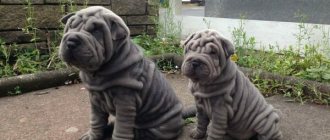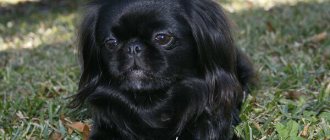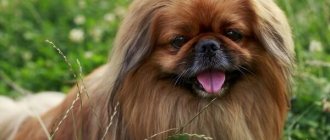Shar Pei is the oldest and most interesting breed of dog. According to scientists, the breed has Chinese roots.
Shar Pei belong to guard hunting dogs, the characteristic features of which are skin folds on the head and shoulders, and due to the peculiar structure of the muzzle, they resemble small hippopotamuses.
The size of the representatives of the breed is average, weight up to 30 kg, height 44-60 cm.
Do mini Shar-Peis exist and what do they look like in the photo?
Recently, miniature dogs have been gaining unprecedented popularity among dog lovers. Given this trend, breeders are breeding mini dogs that are smaller in size compared to their counterparts..
This is how mini Shar-Peis, or, as they are otherwise called, mini-Peis, became popular.
Mini-Peis have been around for quite some time, however, they are not recognized as a separate breed.
Considering the fact that their breeding around the world is quite common, and there are many clubs dedicated specifically to the miniature version of the Shar Pei, experts are talking about the emergence of a new breed variety.
At the moment, mini Shar-Peis are considered a breeding defect, dwarfs who have not grown to the standard size of the breed by the age of one year.
Mini Shar-Peis appear in litters of purebreds. Their parents have standard sizes for the breed.
At first it is difficult to select a mini-pei from a litter; only by 4 weeks of age does it become clear which of the puppies will be mini .
Where does the Shar Pei breed come from?
Many dogs with a long history do not have such a simple origin, and Shar-Peis are no exception. Archaeologists at the site of the ruins of the imperial estates of the Chinese Han family discovered a mass of figurines depicting dogs that resembled the ancestors of modern Shar-Peis.
Experts say that this breed was previously intended for peasants for hunting and guarding. However, at some point, lovers of cruel entertainment coveted these animals, as a result of which Shar Peis for some period turned into fighting dogs. In those days, aggression towards other representatives of the animal world was highly encouraged.
There are two versions of who the ancestor of this breed is. Starting from one of the available ones, it was a smooth-haired chow-chow dog. Another version points to a mastiff.
Personality of mini-pei
The Mini Pei is a full-fledged representative of the breed with all the characteristic characteristics, the only difference is the pet’s growth.
A distinctive feature of the character is pronounced leadership qualities . Mini Shar-Peis cannot be called flexible and obedient babies; they require a firm hand from their owner. experienced in raising and training dogs.
Despite the serious expression on their faces, minis are quite cheerful and playful.
They are loyal to their owner, but can be disobedient towards children or elderly people in the family . Mini-pei have peculiar relationships with other animals; they are sometimes cocky towards other dogs and cats.
The Mini Shar Pei has retained the protective qualities of the breed; it is wary of strangers and will protect the property of its owner and himself to the last.
With proper upbringing , a mini-pei will not cause problems; it can become a caring friend, a guard, and show calm and balance .
Expert opinion
Kozhevin Semyon Kirillovich
Expert dog handler.
“The Shar Pei breed is loved by many; they are ancient representatives of man’s four-legged friends, who captivated us with their extraordinary appearance and strong character. Of course, having a small living space, it is difficult to keep a large or even medium-sized dog. More and more buyers want to get a mini version of their desired breed. Shar Peis are no exception. Mini Shar Peis are similar to their older brothers in everything, the only difference is in height. But before the age of one year, there is a high probability that the dwarf Shar Pei will grow almost to the standard. It is impossible to be 100% sure that a three-month-old mini puppy will not later turn out to be of normal size.”
Purchasing methods
So, you have already decided on the dog breed, all that remains is to choose the characteristics that suit you. First, decide what gender the future puppy will be. There is no fundamental difference in price here, it all depends on your interests. Remember one thing, sharpei bitches have a hard time with whelping, and if you don’t have experience with such things, it’s worth considering. There are 10 main colors in total.
The most common are cream, fawn, red deer, sable, black, apricot and red dilut. The rarest colors for which you will have to pay a decent amount are: cream dilute, blue, chocolate dilute, lilac and isabella dilute.
Now you have decided on all the parameters of the future puppy, the breeder and the amount, all that remains is to deal with the formalities of acquisition and delivery. If the breeder happens to be in another region or city, it doesn’t matter, you just go to his place of residence, fill out the necessary documents, and the baby is yours.
What to do if the nursery where the puppy is kept is located abroad? First of all, decide whether you trust the breeder. Read reviews on the Internet, find out as much as possible about it.
To transport a dog to another country, you need a list of documents, the preparation of which, as a rule, is undertaken by the breeder; you only pay for an international passport and a veterinary examination at least 5 days before the departure date.
Currently, there are a huge number of courier companies that are engaged in the international delivery of animals, the largest of them is Animals Travel. You are paying for the safety and health of your puppy, so be prepared for big expenses as well.
Description of the breed: pros and cons
Like any type of dog that differs in some way from the standard, mini Shar-Peis have their pros and cons.
Among the advantages are the following:
- convenient dimensions, suitable for keeping in a small apartment;
- non-standard appearance;
- good security and protective qualities;
- devotion to the owner and love for the family;
- not picky about care and feeding;
- cleanliness;
- good intellectual qualities.
Among the shortcomings of the mini are::
- tendency to certain diseases;
- stubbornness in character;
- short temper towards other dogs;
- constant desire to communicate with the owner, cannot tolerate loneliness;
- the need for strict education and training.
By purchasing a mini puppy, the owner takes responsibility for his fate, and regardless of external signs and character traits, any pet needs love and affection from him.
Training and education
It is necessary to define the boundaries of what is permitted and begin to teach your pet the rules of behavior as early as possible . It is important from the first days of a puppy’s arrival in the house to show him that he is not the head of the family, but the owner.
This will require showing character and persistence, but not physically punishing the dog.
First of all, it is necessary to accustom the puppy to the nickname and command “come to me”; for this you need to call him as often as possible and reward him with a treat or another portion of food.
This will help reinforce the positive associations associated with the name and coming to the owner.
Then you should teach the pet the commands “sit”, gently pressing on the lower back, forcing him to sit and encouraging him with a treat, and “place” - having sat the dog down and calling the command out loud, you need to gradually move away from it to a further distance, making sure that the pet does not follow the owner.
The prohibition commands “fu” and “no” are also necessary . The main thing when teaching them is to behave seriously and not joke, so that the dog correctly evaluates the command from the very beginning and takes it as a call for games or something similar.
Commands such as “show your teeth”, “give me your paw”, “lie down”, etc. are not mandatory, but may be useful in the future even for performing hygiene procedures.
Dimensions, weight and other distinctive features
Distinctive external features of mini-pei are presented in table form.
| Height | Weight | External features | Wool |
| Height at the withers is up to 43 cm. | up to 25 kg |
| Mini-pei's coat is short, close-lying, and comes in three types:
Possible coat colors:
|
| Optimal average height - 35 cm | |||
| Minimum - 28 cm |
History of the origin of the breed
The Shar Pei is a Molossoid-like dog. This is one of the most ancient breeds. The Shar Pei shares common ancestors with Mastiffs. And the relationship with the Chow Chow is indicated by the blue tongue, which is characteristic only of these breeds. Genetic analysis has revealed that Shar Peis existed already 3 thousand years ago.
In ancient times, they were the dogs of Chinese peasants, helping them guard their livestock and property. They were also used as fighting weapons. Coarse hair and many folds in the skin, which did not fit tightly to the body, helped them avoid serious injuries during dog fights. At that time, these dogs were larger, weighing up to 80 kg.
The breed flourished during the Han Dynasty, when representatives of the nobility became interested in these strong, hard-working dogs. Due to the presence of hunting instincts, they began to be used in hunting large game. Since the 13th century, the breed has become less popular due to constant wars. Interest in Shar-Peis arose again in the 18th century. These dogs were valued for their working qualities and were owned by both peasants and rich people.
In the middle of the 20th century, with the communists coming to power, the breed was on the verge of destruction. These dogs were declared useless. First, a high tax was imposed on them, and then they began to be completely exterminated. By the end of the 60s, representatives of the breed survived only in Taiwan and Macau.
Shar Peis were rescued by dog breeders from the USA. 5 representatives of the breed were included here. They attracted the interest of breeders, who began to buy surviving Shar Peis and transport them to Hong Kong. Those dogs were more graceful, tall-legged. The first breed standard was created in 1976.
It was first registered under the name "Chinese Fighting Dog". Then the ancient name stuck. The standard was changed several times, bringing it closer to the description of these Chinese dogs. Now adopted in 1981, since that time the breed has been recognized throughout the world. Shar Peis appeared in Russia only in the 90s.
Lifespan
Mini-Peis, like standard representatives of the breed, live on average 10-12 years.
In pets with good heredity, life expectancy can reach up to 14 years, but if there is a hereditary tendency to diseases, then the indicator drops to 9 years.
Miniature representatives of the breed, like their older brothers, have good immunity, but they still have a tendency to certain diseases, among which the following are distinguished::
- various types of allergies;
- entropy (turning up of eyelids);
- skin diseases;
- malfunction of the thyroid gland;
- ear infections.
To prevent diseases, it is important to undergo routine examinations with a veterinarian and organize the correct diet and physical activity for your pet.
Shar Pei health
Despite good health, representatives of the breed are susceptible to eye diseases. The most common disease is ectropion of the upper eyelid. It can be identified by copious purulent discharge, redness of the eye membrane, constant squinting and tears.
There are dogs that outwardly do not fully correspond to the standard. For example, their ears do not fit tightly to their heads. Because of this, bacterial lesions develop in the auricle.
These include pityrosporosis (mycosis caused by a lipophilic yeast fungus) and hyperplastic otitis media (inflammation of the middle ear).
In addition, puppies exhibit allergic reactions in the form of itching and blisters on the skin.
Shar Peis also undergo idiopathic mucinosis, in which the coda is damaged both internally and externally.
Care and maintenance
A dog up to 43 cm tall can live quite comfortably in an apartment with the owner’s family.
Mini Shar-Peis are not picky about their care, but it is important to adhere to the basic rules for caring for and maintaining your pet.:
- regular ear cleaning and eye rinsing;
- bathing once every 3-4 months, especially during periods of molting;
- timely brushing of teeth;
- mandatory skin care, which consists of cleaning the skin between the folds and preventing moisture from getting between them;
- warm clothes when walking in the cold season, raincoat during wet weather;
- providing regular and private walks.
CAREFULLY!
Mini Shar-Peis are prone to hypothermia and should not be kept outside.
Proper feeding
One of three options is suitable for feeding the mini version of the Shar Pei.:
- natural (consists of 80% food containing protein, and 20% raw vegetables, fiber and vitamins);
- artificial (try to stick to holistic or premium food, choosing hypoallergenic mixtures);
- mixed (this type of feeding involves taking dry granules in the morning, and meat or offal in the evening).
The dog's food should be balanced and varied, the amount of food is selected taking into account the dog's weight.
Add vitamin complexes to your diet as needed.
Price range
The cost of mini-peas varies from 10,000 to 30,000 rubles, but sometimes the price can exceed these figures, especially when it comes to the offspring of National Breed Club Champions.
Today, mini Shar Pei breeders have managed to ensure that unrecognized babies can participate in the exhibition and receive such a title..
In any case, it is recommended to contact experienced breeders who offer, if not 100% dwarf pei, then completely healthy puppies that do not have hereditary diseases.
The most famous Shar Pei nurseries:
- Helavis (Russia, Yekaterinburg) - Shar-Pei, German Spitz;
- Shat Shun (Russia, Moscow) is a special breed nursery of Shar-Peis - they do not breed minis, but they can offer smaller dogs for sale;
- Gold East (Ukraine, Nikolaev).
How to choose?
No breeder can guarantee that in the future the Shar Pei puppy they sell will be mini size.
One hundred percent guarantees are given only by dishonest sellers who do not care about the future of the pets they release . The likelihood of getting mini-dogs in the litter of standard breeding sires is extremely low.
Sometimes unscrupulous breeders breed two mini-pei (this is prohibited by canine organizations), in this case the likelihood of getting a mini-pei is higher, however, the pets resulting from such mating do not live long and are prone to many diseases.
You need to be wary of breeders who sell thin puppies. Deliberate underfeeding, infection with worms, and the use of unhealthy sires are the tools for obtaining “Mini-Pei puppies.”
IMPORTANT!
If you purchase a dog from unsuccessful breeders, most likely the four-legged dog will come to its senses, catch up with its standard in growth, but will have health problems in adulthood.
Pay attention to customer reviews, the puppy's parents and its condition . It shouldn't look painful!
The prevalence of Mini Shar-Peis is a result of increased interest in miniature dogs. Perhaps in the near future, increased interest in minis and their demand will become a prerequisite for the identification of a new breed.
However, experienced experts do not recommend that future owners chase fashion and inadvertently purchase a puppy with hereditary problems.
Any representative of the Shar Pei breed, regardless of size, is distinguished by its extraordinary appearance and strong-willed character..
Price: what are you willing to pay for?
As mentioned earlier, prices for Shar Pei puppies vary from 7 to 50 thousand rubles. It's time to find out what it consists of.
The main indicator of price is whether the dog was purchased at a poultry market or purchased from a professional breeder. When buying a dog at a poultry market, or from someone else, you run the risk of getting a dog that is sick or not purebred, because these sellers rarely think about the health of dogs.
By purchasing a puppy from a professional breeder, you are guaranteed to receive a dog from the best producers, without genetic defects, healthy and vaccinated. In addition, such dogs will be able to become excellent producers in the future and win good titles.
As a rule, all professional breeders are always in touch with clients, and you can consult with them on any issue that interests you.
So, the main characteristics that people are willing to pay for:
- Good geneticist
- Purebred and healthy sires (father and mother)
- Appearance Features
- Hereditary characteristics.











